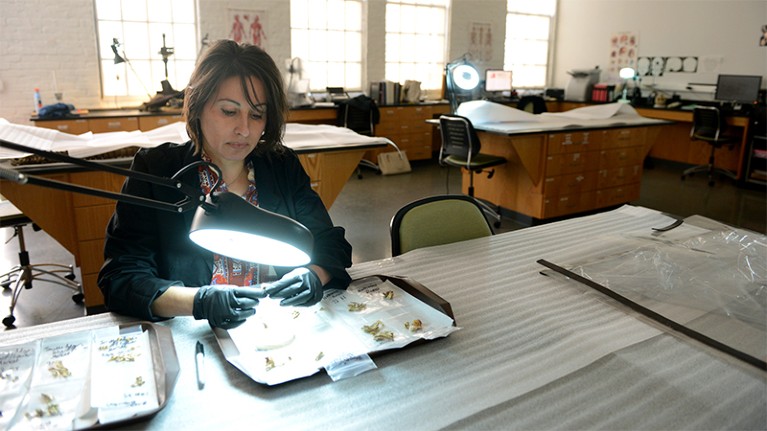
Forensic anthropologist Ann Ross identifying bone fragments in her laboratory.Credit: Marc Hall/NCSU
In the late 1990s, as an anthropology PhD student at the University of Tennessee, Knoxville, Ann Ross travelled to Bosnia to help identify casualties of war. In her current role as head of the Human Identification and Forensic Analysis Laboratory at North Carolina State University in Raleigh, she does much the same for the people of her state. Her lab — a refurbished engineering space measuring about 90 square metres — has a contract with the North Carolina Office of the Chief Medical Examiner, which means that when a human skeleton is recovered, it is her job to determine what happened. The lab has enough tables for four skeletons. Most days, Ross says, all the tables are occupied: her lab is revisiting each of the state’s 130-odd cold cases, many dating back decades, to see whether modern forensic science can shed light on what happened.
“Our methods have changed so much that they really need a fresh set of eyes,” Ross says. The modern techniques she can deploy on old bones include stable isotope analysis to assess an individual’s place of birth, and radiocarbon dating to determine year of birth.
Ross also has methods of her own design. One, a software package called 3D-ID, uses measurements of craniofacial landmarks and a database of 2,372 individuals to estimate ethnicity. Another helps to estimate age at death — a crucial metric when trying to assign a name to unknown remains.
Conventionally, Ross says, age estimates are made visually, based on ‘wear and tear’ of the bones. But wear and tear isn’t necessarily a reliable indicator, because it can be influenced by socio-economic factors, such as diet and occupation. So some forensic anthropologists are making estimates on the basis of bone-mineral density (BMD) instead.
BMD depends mostly on age, Ross notes. BMD readings rise until about the age of 20, plateau, and then fall in adulthood, regardless of diet and activity. That makes BMD, which is measured using a standard hospital scanner, a more reliable metric than visual confirmation, Ross says. But the exact relationship with age remains unclear.
In 2018, researchers in Portugal released an online tool called DXAGE that uses artificial intelligence and BMD data on 100 Portuguese and southern European women aged 21–95 to estimate age at death (D. Navega et al. J. Forensic Sci. 63, 497–503; 2018). Working with researchers at the University of South Florida in Tampa and a collection of some 470 samples, Ross put DXAGE to the test, and found it wanting. Although the software performed well for individuals aged 30–39, estimates for other age ranges were off by between 5 and 23 years (J. D. Bethard et al. J. Forensic Sci. http://doi.org/c4mq; 2018).
In her own work, Ross favours a simple linear-regression model to extrapolate age. Although it can also be prone to errors, it’s easier to explain to a jury, she says. In research, the consequence of a faulty algorithm is wasted time. But in a court of law, lives are on the line. “If you go into court, and the judge asks you, ‘Hey, so how did you develop this?’ And you’re like, ‘I don’t know, the machine did it,’ that’s really not a good answer.”


 The call of the crime lab
The call of the crime lab
 Courage of conviction
Courage of conviction





